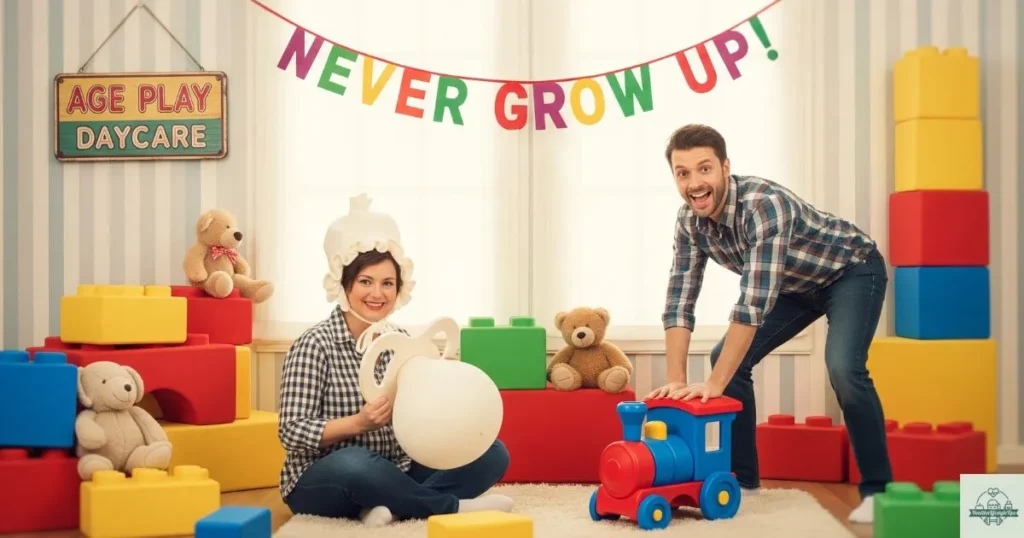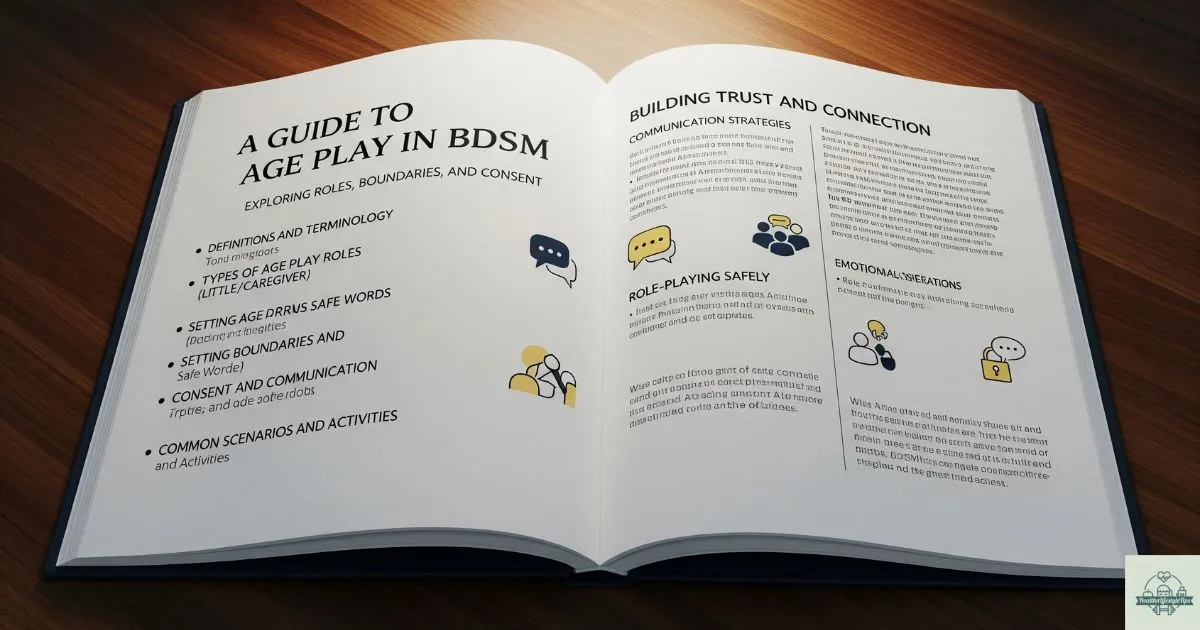Let’s discuss something often misunderstood yet fascinating: age play. If you’re curious about what it is, why people enjoy it, or how to explore it safely, you’re in the right place. This guide will explain age play in simple terms, even if you’re new to it. So grab a cup of tea, get comfy, and let’s dive in!
What is Age Play?

Age play is a form of roleplay where adults pretend to be a different age. It allows people to explore roles, dynamics, or aspects of themselves that they might not express otherwise. For example, one may act as a “little,” such as a child or teen, while another assumes a caregiver role, like “Mommy” or “Daddy.”
Key point: Age play is always between consenting adults. It is not about children; it’s imagination, trust, and connection. Think of it as stepping into another world for a brief moment, for fun, stress relief, or emotional reasons.
Why is Age Play Misunderstood?
Let’s address the elephant in the room: age play gets a bad rap because people don’t understand it. Some believe it’s linked to harmful behavior, but that isn’t true. Age play is about consent, trust, and mutual enjoyment. It’s a roleplay that lets adults explore fantasies safely and with control.
Misunderstandings often come from a lack of education. That’s why it’s so important to talk openly about what age play is—and what it isn’t. By dispelling these misconceptions, we can foster a more accepting and informed community.
What Makes Age Play Unique in BDSM?

Age play is a special part of the larger BDSM world because it combines power exchange with emotional connection. In many cases, one person takes on a nurturing, protective role (like a caregiver), while the other person embraces vulnerability (like a little). This dynamic can be incredibly fulfilling for both parties.
Unlike many BDSM activities, age play often focuses on emotional intimacy over physical sensations. It’s about forming a safe space where both partners can immerse themselves in their roles.
The Roles in Age Play
One exciting aspect of age play is the variety of roles it offers. Here are some common examples:
- Littles: These are individuals who enjoy assuming a childlike role. They might love coloring, playing with toys, or watching cartoons.
- Middles: Middles act like teenagers, often with a rebellious or playful streak. Think mall trips, video games, or even “bratty” behavior.
- Adult Babies: This role involves acting as an infant, using pacifiers, bottles, or diapers.
- Caregivers: These are the nurturing figures, such as mothers, Fathers, or even teachers. They provide guidance, comfort, and structure.
There’s no “right” or “wrong” way to do age play. The key is finding what feels genuine and enjoyable for you and your partner.
How Do I Know If Age Play is Right for Me?
If you’re curious about age play, consider: Does playing a different role excite you?
- Are you seeking a way to alleviate stress or discover a new aspect of yourself?
- Do you enjoy nurturing others or being nurtured yourself?
If you answered “yes,” age play could be worth exploring. It’s about what feels right and safe for you.
How to Talk to Your Partner About Age Play
Bringing up age play with your partner can feel nerve-wracking, but it doesn’t have to be. Here are some tips to make the conversation easier:
- Start by expressing curiosity and learning together.
- Be honest about why age interests you and your hopes for it.
- Listen: Give your partner space to share their thoughts and feelings.
The key is to approach the conversation with openness and respect. Who knows? They might be just as curious as you are!
Setting Up Your First Age Play Scene
Ready to try age play? Here’s how to set a fun, safe scene:
- Choose your roles: Decide who will play the little one, the caregiver, or any other role you’d like to explore.
- Plan activities: Think about what you’d like to do—coloring, storytime, or even a trip to the park.
- Create comfort: Make a cozy space where you both feel at ease.
Remember to discuss boundaries and safe words beforehand. Communication is everything!
The Golden Rule: Consent and Communication
If you take one lesson, let it be this: consent is non-negotiable. Age play, like all BDSM, requires clear, enthusiastic agreement from everyone.
Here’s how to ensure consent and communication stay front and center:
- Discuss boundaries: What’s okay and what’s off-limits?
- Use safe words: These are words or signals that let you pause or stop the scene if needed.
- Check in regularly: Make sure both partners feel comfortable and happy throughout the experience.
Why Do People Love Age Play?
So, why do people enjoy age play? The reasons are as unique as the individuals themselves, but here are a few common ones:
- Stress relief: Stepping into a different role can be a great way to escape the pressures of adult life.
- Emotional connection: Age play often involves deep trust and intimacy, which can strengthen relationships.
- Fun and creativity: Let’s face it—playing pretend is just plain fun!
For many, age play reconnects them with their inner child, offering a sense of freedom and joy.
Can Age Play Be Therapeutic?
For some, age play offers a form of healing. It provides a safe space to explore emotions, rewrite experiences, or feel cared for.
Age play isn’t therapy, but it can complement other forms of self-care.
Debunking Myths About Age Play
Let’s clear up some common misconceptions:
- Myth: Age play is the same as pedophilia.
Fact: Age play is between consenting adults and has nothing to do with minors. - Myth: Age play is always sexual.
Fact: Many people enjoy age play for non-sexual reasons, like stress relief or emotional connection.
By understanding the truth about age play, we can help reduce stigma and create a more accepting community.
How to Handle Stigma as an Age Play Participant
Unfortunately, not everyone understands age play, and that can lead to judgment or criticism. Here’s how to handle it:
- Educate others: Share resources or explain the basics of age play.
- Find your tribe: Join online communities or local groups where you can connect with like-minded people.
- Stay confident: Your preferences are valid and deserve respect.
Conclusion
Age play is a personal expression. Whether you’re new to the field or experienced, remember to keep an open mind, communicate clearly, and always prioritize consent.
Are you ready to explore age play? No matter your journey, remember: have fun, build trust, and always prioritize consent, effective communication, and finding what feels right for you.
FAQs
Is age play the same as age regression?
No, age play and age regression are different. Age play is a consensual roleplay between adults, often within the BDSM community, where participants pretend to be a different age. Age regression, on the other hand, is a coping mechanism where someone involuntarily reverts to a childlike state, often as a response to stress or trauma. Age regression is not sexual, while age play can be sexual or non-sexual, depending on the participants’ preferences.
Is age play always sexual?
No. Age play can be sexual or not. Many enjoy it for connection, stress relief, or nurturing—sometimes with no sexual aspect at all.
How do I discuss trying age play with my partner?
Be open and honest. Share your interests and goals, listen attentively to your partner, and prioritize open communication and mutual respect.
What are some common activities in age play?
Common activities include coloring, playing with toys, watching cartoons, participating in storytime, baking, or going on outings such as trips to the park or zoo. For those who prefer a sexual dynamic, activities might include role-specific scenarios like teacher/student or caregiver/little interactions. The possibilities are endless and depend on the participants’ preferences.
How can I ensure age play is safe and consensual?
Always discuss boundaries, roles, and expectations. Use safe words, check in often, and provide aftercare.
